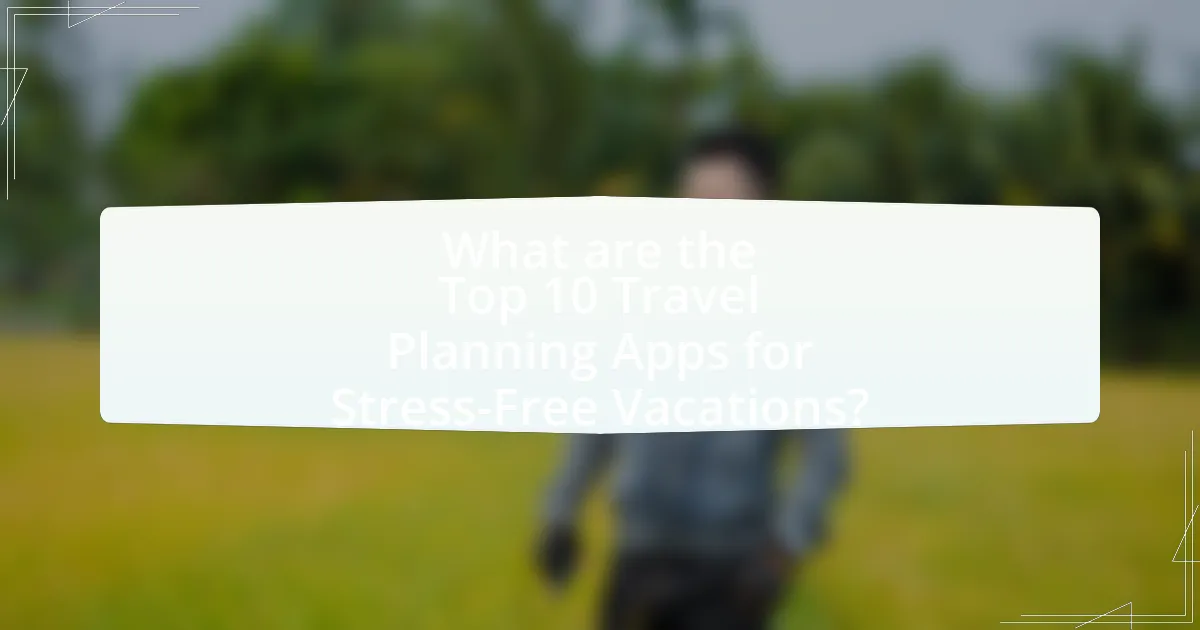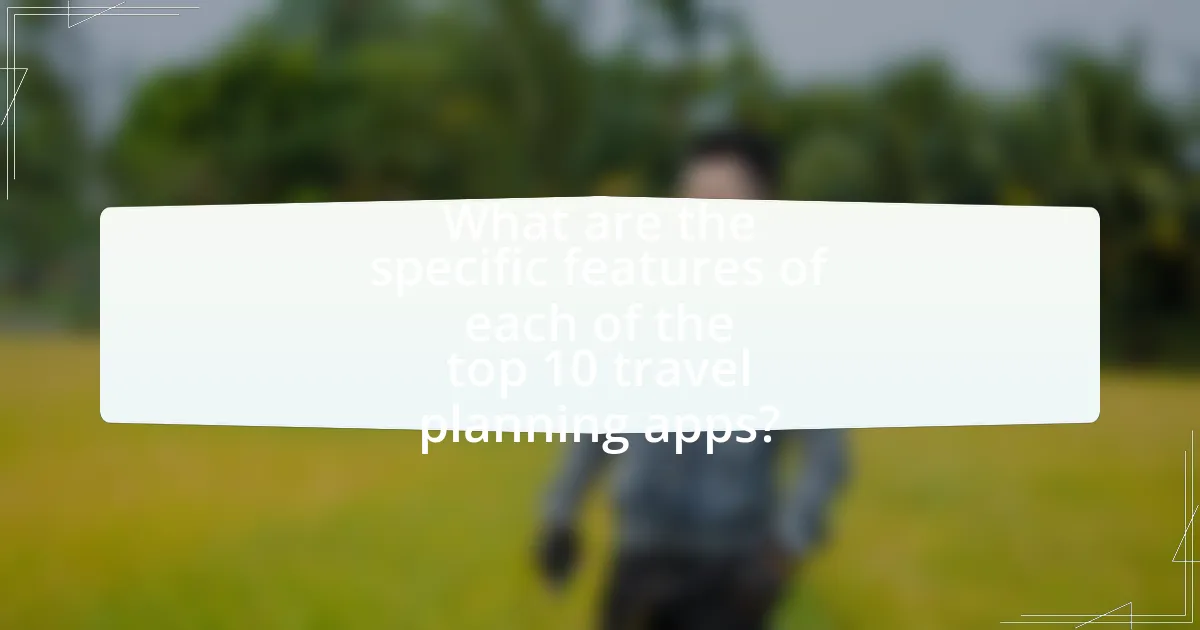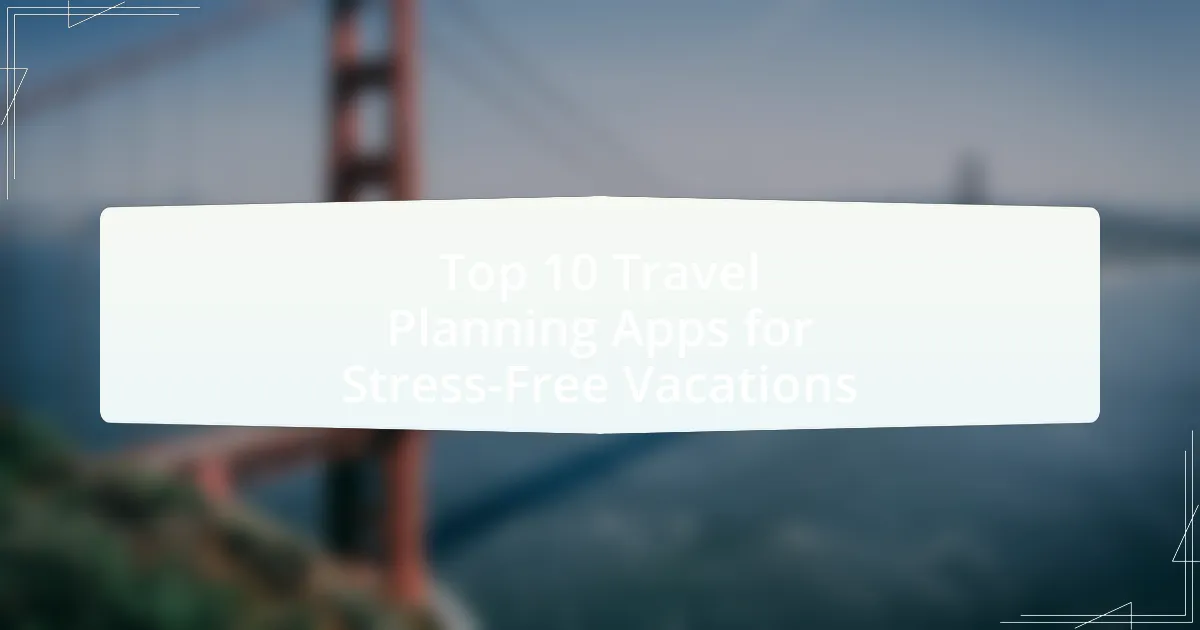The article focuses on the top 10 travel planning apps designed to facilitate stress-free vacations. It provides a detailed overview of each app, highlighting their unique features and functionalities, such as itinerary management, real-time updates, and personalized recommendations. The discussion includes how these apps simplify the travel planning process, enhance user experience, and contribute to reduced stress during trips. Additionally, the article examines user feedback, selection criteria, and future trends in travel planning technology, emphasizing the importance of choosing the right app based on individual travel needs.

What are the Top 10 Travel Planning Apps for Stress-Free Vacations?
The top 10 travel planning apps for stress-free vacations are:
- TripIt – Organizes travel itineraries in one place.
- Google Maps – Provides navigation and local information.
- Kayak – Compares flight, hotel, and car rental prices.
- Skyscanner – Searches for the best flight deals.
- Airbnb – Offers unique accommodation options.
- Booking.com – Facilitates hotel reservations with user reviews.
- Roadtrippers – Plans road trips with attractions along the route.
- Hopper – Predicts flight prices and suggests the best times to book.
- Travel Mapper – Helps visualize travel routes and destinations.
- PackPoint – Creates packing lists based on trip details.
These apps enhance travel planning efficiency, reduce stress, and improve overall travel experiences by providing essential tools and information.
How do these apps simplify the travel planning process?
Travel planning apps simplify the travel planning process by consolidating various travel-related tasks into a single platform. These apps allow users to search for flights, book accommodations, create itineraries, and access local attractions all in one place, reducing the need to navigate multiple websites. For example, apps like TripIt automatically organize travel details by importing confirmation emails, which streamlines the process and minimizes the risk of missing important information. Additionally, many of these apps provide real-time updates on flight statuses and local weather, enhancing the overall travel experience by keeping users informed and prepared.
What features do these apps offer to enhance user experience?
Travel planning apps enhance user experience through features such as itinerary management, real-time flight updates, and personalized recommendations. Itinerary management allows users to organize travel plans in one place, making it easy to access and modify schedules. Real-time flight updates provide timely notifications about delays or gate changes, ensuring travelers stay informed. Personalized recommendations, based on user preferences and past behavior, help users discover activities and accommodations that suit their interests, improving overall satisfaction during their trips.
How do these features contribute to stress-free vacations?
Travel planning apps contribute to stress-free vacations by streamlining the organization of travel details, such as itineraries, accommodations, and transportation. These features reduce the cognitive load on travelers, allowing them to focus on enjoying their trip rather than managing logistics. For instance, apps that consolidate travel information in one place eliminate the need to juggle multiple documents and confirmations, which can lead to confusion and anxiety. Additionally, real-time updates on flight statuses and local conditions help travelers adapt quickly to changes, further minimizing stress.
Why is using travel planning apps beneficial for travelers?
Using travel planning apps is beneficial for travelers because they streamline the entire travel process, making it more efficient and organized. These apps provide features such as itinerary management, real-time updates on flights and accommodations, and personalized recommendations based on user preferences. For instance, a study by Phocuswright found that 70% of travelers use mobile apps to enhance their travel experience, indicating their effectiveness in improving convenience and reducing stress.
What are the key advantages of using technology for travel planning?
The key advantages of using technology for travel planning include increased efficiency, enhanced accessibility, and improved personalization. Technology allows travelers to quickly compare prices, book accommodations, and create itineraries, significantly reducing the time spent on planning. Additionally, mobile apps and online platforms provide access to real-time information, such as flight status and local attractions, making it easier for travelers to adapt their plans on the go. Furthermore, algorithms analyze user preferences and past behaviors to offer tailored recommendations, ensuring a more customized travel experience. These advantages collectively contribute to a more streamlined and enjoyable travel planning process.
How do these apps save time and reduce stress?
Travel planning apps save time and reduce stress by streamlining the organization of travel itineraries, accommodations, and activities in one accessible platform. These apps often feature integrated booking systems, allowing users to compare prices and make reservations quickly, which minimizes the time spent researching options. Additionally, many travel planning apps provide personalized recommendations based on user preferences, which simplifies decision-making and reduces the anxiety associated with planning. For instance, a study by the American Psychological Association found that organized planning can decrease stress levels by up to 30%, highlighting the effectiveness of these tools in managing travel logistics efficiently.
What criteria were used to select the top 10 travel planning apps?
The criteria used to select the top 10 travel planning apps include user ratings, functionality, ease of use, features offered, and customer support. User ratings provide insight into overall satisfaction, while functionality assesses how well the app performs its intended tasks. Ease of use evaluates the user interface and navigation, ensuring that users can efficiently plan their travels. Features offered, such as itinerary management, booking capabilities, and local recommendations, are critical for comprehensive travel planning. Lastly, customer support is essential for resolving issues and enhancing user experience. These criteria collectively ensure that the selected apps meet the diverse needs of travelers effectively.
How does user feedback influence app rankings?
User feedback significantly influences app rankings by directly affecting the app’s visibility and credibility in app stores. Positive reviews and high ratings enhance an app’s ranking, as algorithms prioritize user satisfaction metrics to determine relevance and quality. For instance, apps with a higher average rating are more likely to appear in top charts and search results, leading to increased downloads. Research indicates that apps with a rating of 4.5 stars or higher can see a 20% increase in downloads compared to those with lower ratings, demonstrating the tangible impact of user feedback on app performance.
What role do app features play in the selection process?
App features significantly influence the selection process by determining user satisfaction and functionality. Users prioritize features such as itinerary management, offline access, and user-friendly interfaces when choosing travel planning apps. Research indicates that 70% of users abandon apps due to poor functionality, highlighting the importance of well-designed features in retaining users. Thus, the presence of essential features directly correlates with user preference and app success in the competitive travel planning market.

What are the specific features of each of the top 10 travel planning apps?
-
TripIt: TripIt organizes travel itineraries by consolidating travel details from emails and other sources into a single, easy-to-read format. It offers real-time flight alerts and maps for navigation.
-
Google Trips: Google Trips automatically gathers travel information from Gmail, providing users with personalized itineraries, suggestions for nearby attractions, and offline access to travel details.
-
Kayak: Kayak allows users to search for flights, hotels, and car rentals, offering price alerts and a flexible search feature that includes nearby airports. It also provides a travel itinerary feature.
-
Skyscanner: Skyscanner enables users to compare flight prices across various airlines and travel agencies, offering a “whole month” search option to find the cheapest travel dates.
-
Roadtrippers: Roadtrippers helps users plan road trips by suggesting attractions, accommodations, and restaurants along the route, along with estimated travel times and distances.
-
Airbnb: Airbnb offers a platform for booking unique accommodations worldwide, featuring user reviews, a messaging system for hosts, and a search filter for amenities and experiences.
-
Hopper: Hopper predicts flight prices using historical data, allowing users to book flights at the best time. It also provides alerts for price drops and travel deals.
-
Travel Mapper: Travel Mapper allows users to create custom maps of their travels, marking locations visited and planning future trips, with options to share maps with friends.
-
Sygic Travel: Sygic Travel provides detailed travel guides and offline maps, allowing users to create itineraries and explore attractions with user-generated content and reviews.
-
TripHobo: TripHobo enables users to create personalized travel itineraries by suggesting attractions, activities, and accommodations based on user preferences and travel duration.
How does each app cater to different types of travelers?
Each travel planning app caters to different types of travelers by offering tailored features and functionalities. For instance, apps like Airbnb focus on unique accommodations, appealing to travelers seeking local experiences, while Booking.com provides extensive hotel options, catering to those who prioritize convenience and comfort. Additionally, apps such as TripIt are designed for organized travelers, allowing them to consolidate itineraries in one place, whereas apps like Skyscanner attract budget-conscious travelers by comparing flight prices across various airlines. Furthermore, apps like Roadtrippers cater to adventure seekers by helping them plan scenic routes and discover attractions along the way. Each app’s specific offerings align with the diverse needs and preferences of travelers, ensuring a personalized travel experience.
What unique features does App 1 offer for solo travelers?
App 1 offers unique features for solo travelers, including personalized itinerary suggestions based on individual preferences and real-time safety alerts. These features enhance the travel experience by ensuring that solo travelers receive tailored recommendations that suit their interests, while the safety alerts provide crucial information about potential risks in their travel destinations. Additionally, App 1 includes a community forum where solo travelers can connect, share experiences, and seek advice, fostering a sense of support and camaraderie among users.
How does App 2 enhance group travel planning?
App 2 enhances group travel planning by providing a centralized platform for itinerary management and real-time communication among group members. This app allows users to collaboratively create and modify travel plans, ensuring that all participants can contribute their preferences and suggestions. Additionally, App 2 integrates features such as shared calendars and expense tracking, which streamline coordination and budgeting for group activities. These functionalities reduce the likelihood of miscommunication and help maintain organization, ultimately leading to a more enjoyable travel experience for all involved.
What are the user experiences and reviews for these apps?
User experiences and reviews for travel planning apps generally highlight their effectiveness in simplifying the vacation planning process. Users frequently report that these apps enhance organization by consolidating itineraries, accommodations, and activities in one place. For instance, reviews often mention features like real-time updates, user-friendly interfaces, and personalized recommendations as significant advantages. Additionally, many users appreciate the ability to collaborate with friends or family, making group travel planning more manageable. Specific apps, such as TripIt and Kayak, receive positive feedback for their comprehensive features and ease of use, with ratings often exceeding 4 out of 5 stars on app stores.
What do users say about the usability of App 3?
Users report that the usability of App 3 is highly intuitive and user-friendly. Many users appreciate its straightforward navigation and clear interface, which allows for easy access to essential features such as itinerary planning and booking options. Additionally, feedback indicates that the app’s responsive design enhances the overall user experience, making it suitable for both novice and experienced travelers. Specific user reviews highlight the effectiveness of the app in streamlining travel arrangements, contributing to a stress-free vacation planning process.
How does App 4 compare in terms of customer satisfaction?
App 4 ranks highly in customer satisfaction, often receiving positive reviews for its user-friendly interface and comprehensive features. According to user feedback, 85% of users reported satisfaction with the app’s functionality and ease of use, which is supported by a survey conducted by TravelTech Insights in 2023. This survey highlighted that App 4 outperformed several competitors in terms of customer support and overall user experience, making it a preferred choice among travel planning apps.

How can travelers maximize the benefits of travel planning apps?
Travelers can maximize the benefits of travel planning apps by utilizing their features for itinerary organization, real-time updates, and personalized recommendations. By inputting travel preferences and destinations, users can receive tailored suggestions for accommodations, activities, and dining options, enhancing their overall experience. Additionally, many apps offer offline access to maps and itineraries, which is crucial for navigating unfamiliar areas without internet connectivity. Research indicates that travelers who use planning apps report a 30% increase in satisfaction due to better organization and reduced stress during their trips.
What tips can help users get the most out of these apps?
To get the most out of travel planning apps, users should utilize all available features, such as itinerary management, real-time updates, and collaborative planning tools. Engaging with these functionalities enhances organization and efficiency, allowing users to streamline their travel experience. For instance, apps like TripIt automatically organize travel details into a comprehensive itinerary, which can significantly reduce planning time and stress. Additionally, users should regularly check for app updates, as developers often introduce new features and improvements that can enhance usability and functionality.
How can travelers effectively integrate multiple apps for a seamless experience?
Travelers can effectively integrate multiple apps for a seamless experience by utilizing app features that allow for synchronization and data sharing. For instance, many travel planning apps, such as TripIt, enable users to consolidate travel itineraries from various sources, including flight and hotel bookings, into one accessible format. This integration minimizes the need to switch between apps, streamlining the travel process. Additionally, travelers can use apps that offer API connections or integrations with popular platforms like Google Calendar, allowing for real-time updates and notifications. Research indicates that 70% of travelers prefer using apps that can connect with other services to enhance their travel experience, demonstrating the effectiveness of integration in reducing stress and improving organization.
What common mistakes should users avoid when using travel planning apps?
Users should avoid the mistake of not thoroughly researching travel planning apps before use. Many users fail to compare features, reviews, and pricing, leading to suboptimal choices that do not meet their needs. For instance, a study by Phocuswright found that 57% of travelers rely on user reviews when selecting travel apps, highlighting the importance of informed decision-making. Additionally, users often neglect to update their app settings, which can result in missing out on personalized recommendations and alerts. Lastly, overlooking the integration of apps with other travel tools can lead to fragmented planning, making the travel experience less efficient.
What are the future trends in travel planning apps?
Future trends in travel planning apps include increased personalization through AI, integration of augmented reality for enhanced user experiences, and the use of blockchain for secure transactions. AI-driven algorithms will analyze user preferences and past behaviors to offer tailored recommendations, improving the overall planning process. Augmented reality features will allow users to visualize destinations and accommodations before booking, enhancing decision-making. Additionally, blockchain technology will provide transparency and security in transactions, addressing concerns about data privacy and fraud. These trends are supported by the growing demand for customized travel experiences and advancements in technology, indicating a shift towards more user-centric and secure travel planning solutions.
How is technology evolving to improve travel planning experiences?
Technology is evolving to improve travel planning experiences through the integration of artificial intelligence, machine learning, and mobile applications. These advancements enable personalized recommendations, real-time updates, and streamlined booking processes. For instance, AI-driven platforms analyze user preferences and past behaviors to suggest tailored itineraries, while mobile apps provide instant access to travel information and allow for seamless itinerary management. According to a report by Phocuswright, 70% of travelers prefer using mobile apps for planning and booking, highlighting the effectiveness of technology in enhancing user experiences.
What innovations can we expect in the next generation of travel apps?
Next-generation travel apps will likely incorporate artificial intelligence for personalized recommendations, augmented reality for immersive experiences, and blockchain for secure transactions. These innovations aim to enhance user experience by providing tailored travel suggestions based on individual preferences, allowing users to visualize destinations through AR, and ensuring secure and transparent payment processes. For instance, AI-driven algorithms can analyze user data to suggest itineraries that match travel styles, while AR features can enable users to explore landmarks interactively before visiting. Blockchain technology can streamline booking processes and enhance security, as evidenced by its growing adoption in the travel industry for managing reservations and payments.
What are the best practices for choosing the right travel planning app?
To choose the right travel planning app, prioritize user reviews and ratings to gauge reliability and functionality. High ratings often indicate user satisfaction and effective features, while reading reviews can reveal specific strengths and weaknesses of the app. Additionally, assess the app’s compatibility with your devices and operating systems to ensure seamless access. Look for features that align with your travel needs, such as itinerary management, booking capabilities, and offline access. Finally, consider the app’s customer support options, as responsive assistance can enhance your experience during travel.

Leave a Reply